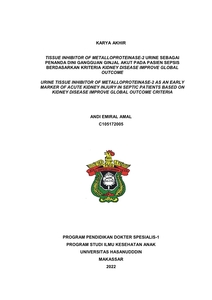Amal, Andi Emiral (2022) TISSUE INHIBITOR OF METALLOPROTEINASE-2 URINE SEBAGAI PENANDA DINI GANGGUAN GINJAL AKUT PADA PASIEN SEPSIS BERDASARKAN KRITERIA KIDNEY DISEASE IMPROVE GLOBAL OUTCOME = URINE TISSUE INHIBITOR OF METALLOPROTEINASE-2 AS AN EARLY MARKER OF ACUTE KIDNEY INJURY IN SEPTIC PATIENTS BASED ON KIDNEY DISEASE IMPROVE GLOBAL OUTCOME CRITERIA. Thesis thesis, Universitas Hasanuddin.
![[thumbnail of Cover]](/33607/1.hassmallThumbnailVersion/C105172005_tesis_06-01-2023%20cover1.jpg)

C105172005_tesis_06-01-2023 cover1.jpg
Download (322kB) | Preview
C105172005_tesis_06-01-2023 bab 1-3.pdf
Download (1MB)
C105172005_tesis_06-01-2023 dp.pdf
Download (871kB)
C105172005_tesis_06-01-2023.pdf
Restricted to Repository staff only until 1 January 2025.
Download (3MB)
Abstract (Abstrak)
Introduction: Sepsis is a systemic process of inflammation causing renal microcirculation disease, cell damage, and acute tubular necrosis that may induce the development of acute kidney injury (AKI). Over the past years, the involvement of tissue inhibitor of metalloproteinase-2 (TIMP2) in AKI has been established. Urine TIMP2 is recognized as an early biomarker for predicting the occurrence of AKI in critically ill patients, especially in patients with sepsis, however, its role is yet to be explored.
Objective: This study aims to analyze the role of urine TIMP2 to predict the occurrence of sepsis induced AKI in children based on kidney disease improve global outcome (KDIGO) criteria.
Methods: This study used a prospective cohort design which was conducted at the Educational General Hospital (RSUP) Dr. Wahidin Sudirohusodo, Makassar. The population of this study are all sepsis patients from1 month old to 18 years old hospitalized at intensive care. This study compared urine TIMP2 levels in a group of sepsis with AKI and a group of sepsis without AKI, determining cut-off point, and determining prognostic value of urine TIMP2 as early biomarker for AKI.
Results: This study involved 86 patients with sepsis who were divided into 2 groups, 23 patients in the AKI group and 63 patients in the non-AKI group. Based on analysis, age, leukocycte, thrombocytopenia, and postoperative patient affected the value of TIMP2 AKI (p <0.05). Urine TIMP2 levels had a significant difference in the incidence of AKI in septic patients with a mean value of 2.31 ng/ml (p=0,000) and the receiver operating characteristic (ROC) curve with cut off point for urine TIMP2 level of ≥ 0.6225 ng/ml with 78,26% sensitivity and 80,95% specificity, odds ratio (OR) of 15.3 with CI 95% 4,372–49.470, positive predictive value 60 and negative predictive value 91.07. In the multivariate analysis, 3 factors influenced the incidence of AKI in sepsis patients, namely urine TIMP2, age and thrombocytopenia.
Conclusion: Urine TIMP2 level in sepsis patients were higher in AKI group than non-AKI. TIMP2 level is one of the parameters that can predict the
Kata kunci : TIMP2,Sepsis, GgGA, Anak, Nilai prediktor Key words: TIMP2, Sepsis, AKI, Pediatric, Predictor value.
| Item Type: | Thesis (Thesis) |
|---|---|
| Uncontrolled Keywords: | TIMP2, Sepsis, AKI, Pediatric, Predictor value. |
| Subjects: | R Medicine > R Medicine (General) |
| Divisions (Program Studi): | Fakultas Kedokteran > PPDS Ilmu Kesehatan Anak |
| Depositing User: | S.Sos Rasman - |
| Date Deposited: | 17 May 2024 05:59 |
| Last Modified: | 17 May 2024 05:59 |
| URI: | http://repository.unhas.ac.id:443/id/eprint/33607 |


